Accounting Theory: Analyzing Depreciation Method Changes and Ethics
VerifiedAdded on 2020/05/28
|8
|2716
|55
Report
AI Summary
This report analyzes a case study involving Sunshine Ltd, a departmental store, where the general manager seeks to maintain profit growth despite economic slowdown predictions. The manager proposes changing the depreciation method from straight-line to sum-of-years-of-digits to manipulate profit figures. The accountant, recognizing the lack of a valid reason and potential ethical violations, changes the method but does not disclose it. The report examines the accountant's role, the impact of the change on financial statements, the relevance of AASB116, ethical responsibilities, and the shareholders' perspective. It highlights the importance of disclosing accounting policy changes, the potential for fines and penalties for non-compliance, and the ethical implications of manipulating financial data. The report concludes that the company's actions violate ethical standards and legal requirements, potentially damaging its goodwill and shareholder trust. It emphasizes the need for transparency and adherence to accounting standards to ensure fair financial reporting.
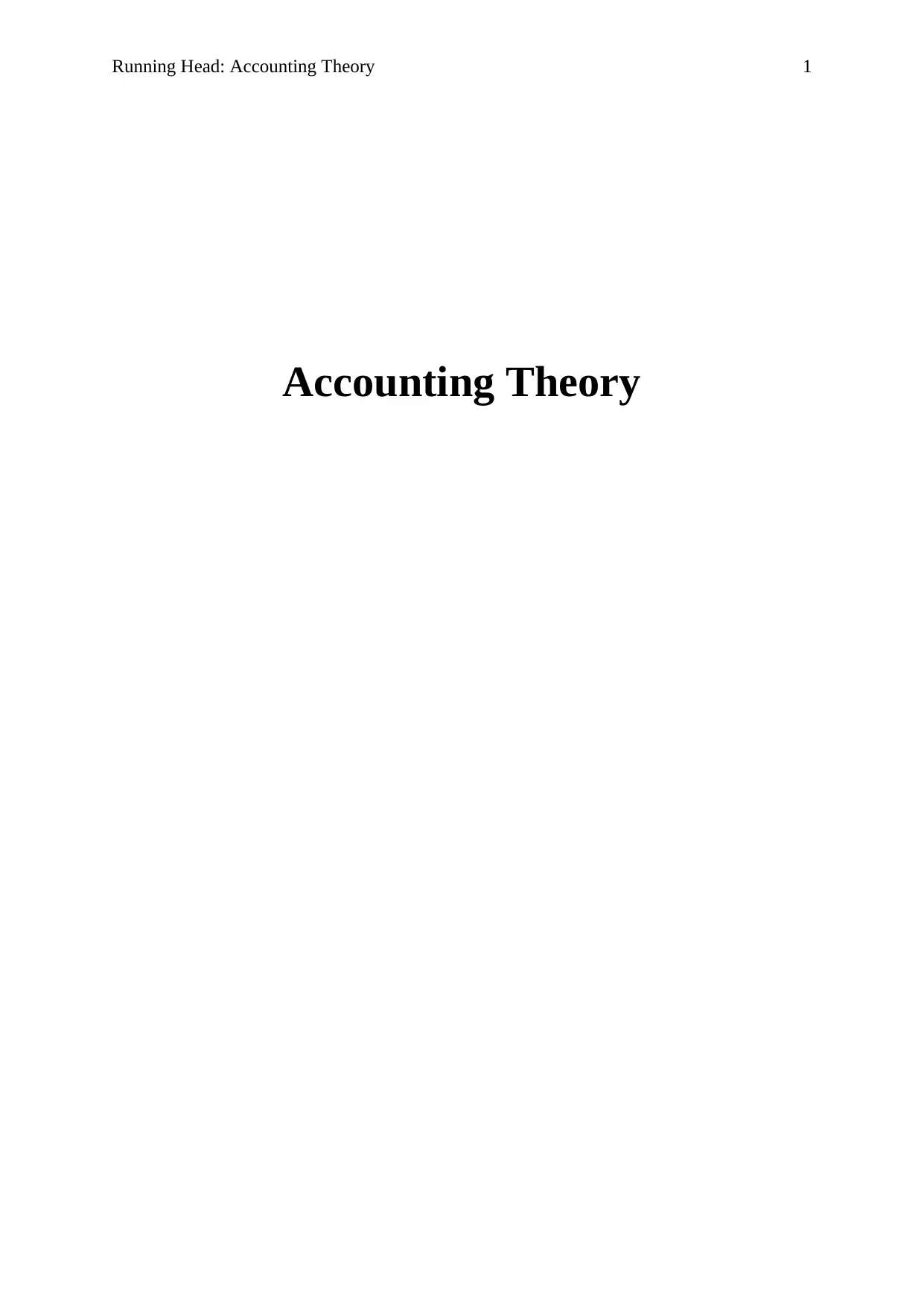
Running Head: Accounting Theory 1
Accounting Theory
Accounting Theory
Paraphrase This Document
Need a fresh take? Get an instant paraphrase of this document with our AI Paraphraser
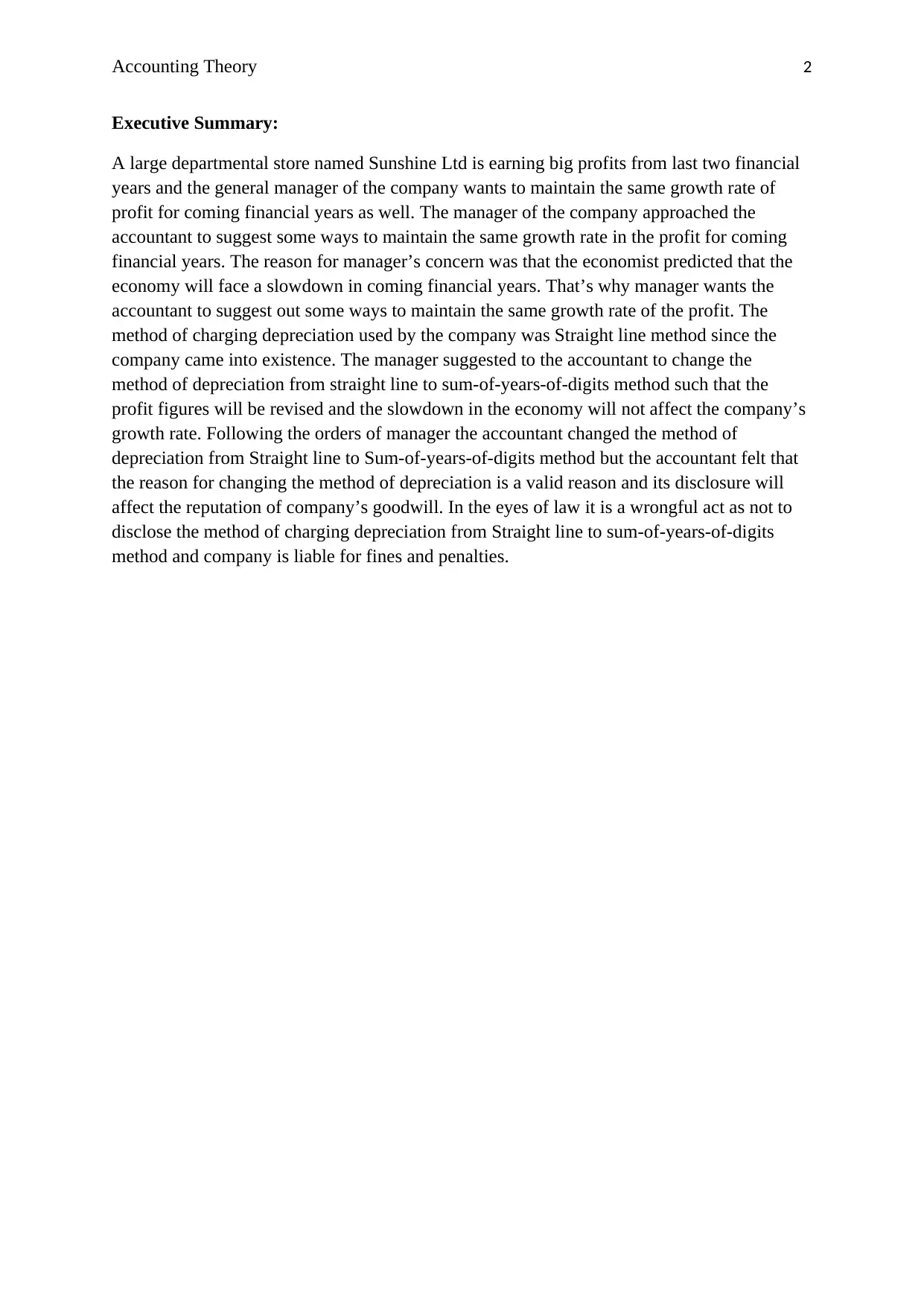
Accounting Theory 2
Executive Summary:
A large departmental store named Sunshine Ltd is earning big profits from last two financial
years and the general manager of the company wants to maintain the same growth rate of
profit for coming financial years as well. The manager of the company approached the
accountant to suggest some ways to maintain the same growth rate in the profit for coming
financial years. The reason for manager’s concern was that the economist predicted that the
economy will face a slowdown in coming financial years. That’s why manager wants the
accountant to suggest out some ways to maintain the same growth rate of the profit. The
method of charging depreciation used by the company was Straight line method since the
company came into existence. The manager suggested to the accountant to change the
method of depreciation from straight line to sum-of-years-of-digits method such that the
profit figures will be revised and the slowdown in the economy will not affect the company’s
growth rate. Following the orders of manager the accountant changed the method of
depreciation from Straight line to Sum-of-years-of-digits method but the accountant felt that
the reason for changing the method of depreciation is a valid reason and its disclosure will
affect the reputation of company’s goodwill. In the eyes of law it is a wrongful act as not to
disclose the method of charging depreciation from Straight line to sum-of-years-of-digits
method and company is liable for fines and penalties.
Executive Summary:
A large departmental store named Sunshine Ltd is earning big profits from last two financial
years and the general manager of the company wants to maintain the same growth rate of
profit for coming financial years as well. The manager of the company approached the
accountant to suggest some ways to maintain the same growth rate in the profit for coming
financial years. The reason for manager’s concern was that the economist predicted that the
economy will face a slowdown in coming financial years. That’s why manager wants the
accountant to suggest out some ways to maintain the same growth rate of the profit. The
method of charging depreciation used by the company was Straight line method since the
company came into existence. The manager suggested to the accountant to change the
method of depreciation from straight line to sum-of-years-of-digits method such that the
profit figures will be revised and the slowdown in the economy will not affect the company’s
growth rate. Following the orders of manager the accountant changed the method of
depreciation from Straight line to Sum-of-years-of-digits method but the accountant felt that
the reason for changing the method of depreciation is a valid reason and its disclosure will
affect the reputation of company’s goodwill. In the eyes of law it is a wrongful act as not to
disclose the method of charging depreciation from Straight line to sum-of-years-of-digits
method and company is liable for fines and penalties.
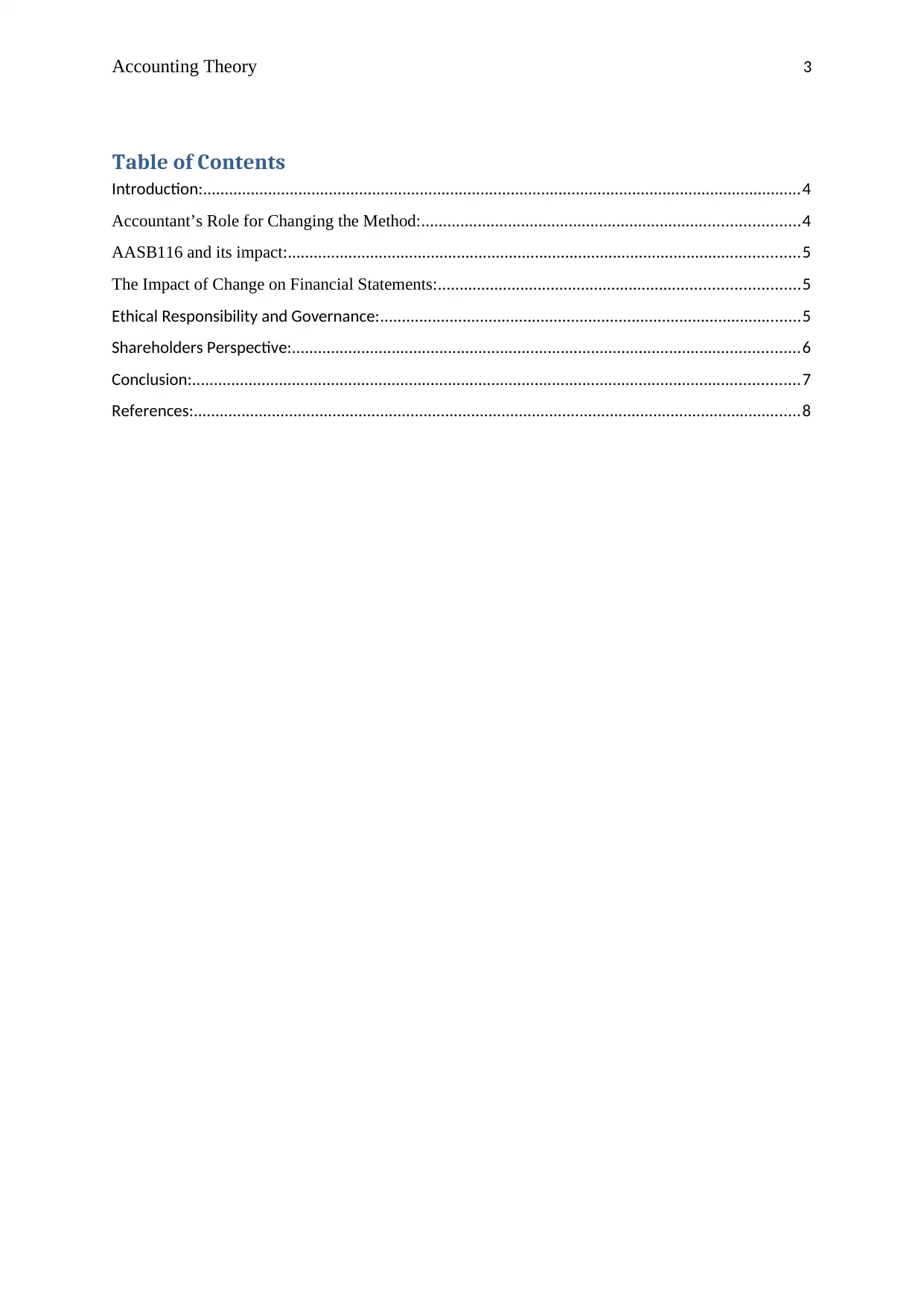
Accounting Theory 3
Table of Contents
Introduction:..........................................................................................................................................4
Accountant’s Role for Changing the Method:.......................................................................................4
AASB116 and its impact:......................................................................................................................5
The Impact of Change on Financial Statements:...................................................................................5
Ethical Responsibility and Governance:.................................................................................................5
Shareholders Perspective:.....................................................................................................................6
Conclusion:............................................................................................................................................7
References:............................................................................................................................................8
Table of Contents
Introduction:..........................................................................................................................................4
Accountant’s Role for Changing the Method:.......................................................................................4
AASB116 and its impact:......................................................................................................................5
The Impact of Change on Financial Statements:...................................................................................5
Ethical Responsibility and Governance:.................................................................................................5
Shareholders Perspective:.....................................................................................................................6
Conclusion:............................................................................................................................................7
References:............................................................................................................................................8
⊘ This is a preview!⊘
Do you want full access?
Subscribe today to unlock all pages.

Trusted by 1+ million students worldwide
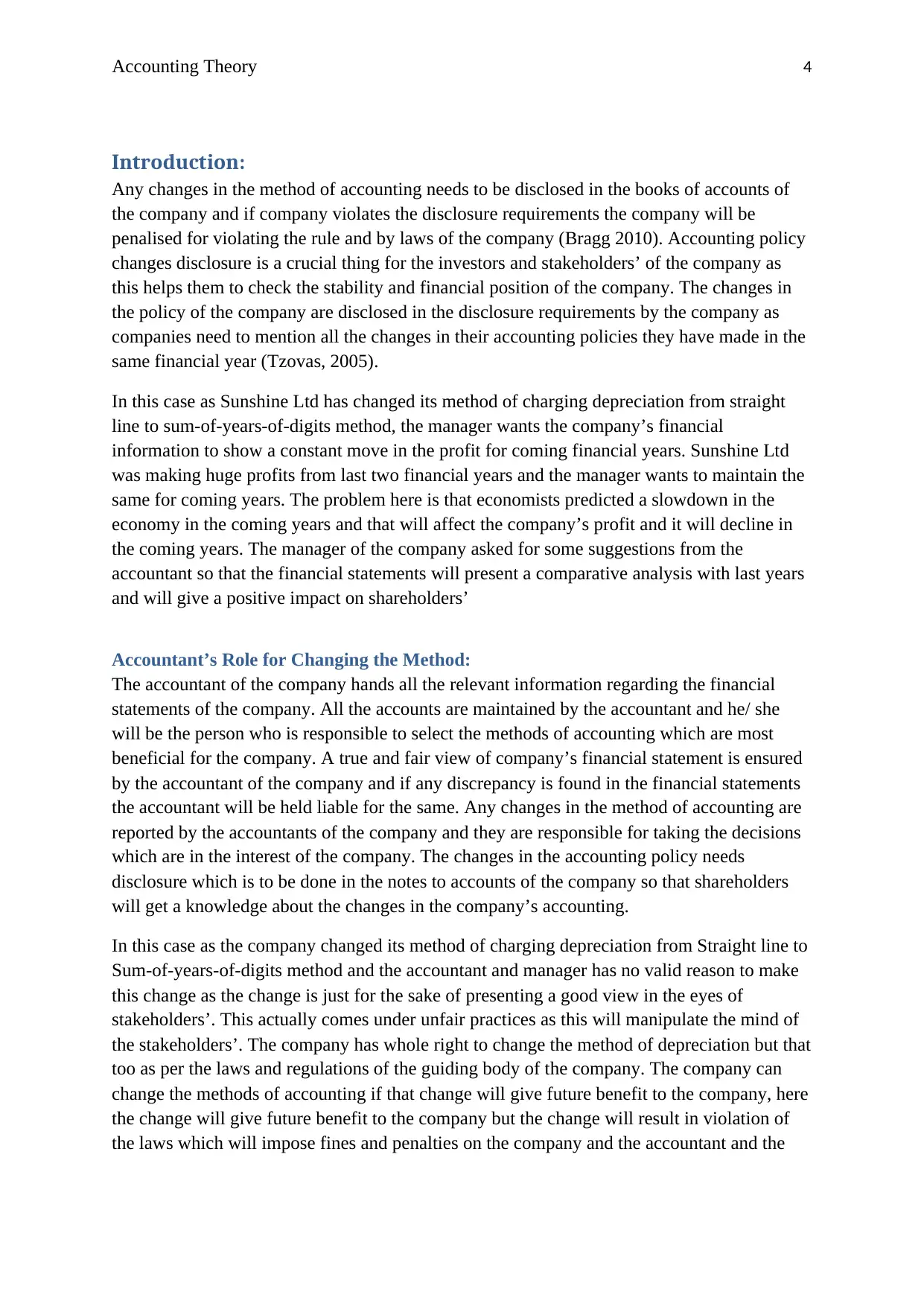
Accounting Theory 4
Introduction:
Any changes in the method of accounting needs to be disclosed in the books of accounts of
the company and if company violates the disclosure requirements the company will be
penalised for violating the rule and by laws of the company (Bragg 2010). Accounting policy
changes disclosure is a crucial thing for the investors and stakeholders’ of the company as
this helps them to check the stability and financial position of the company. The changes in
the policy of the company are disclosed in the disclosure requirements by the company as
companies need to mention all the changes in their accounting policies they have made in the
same financial year (Tzovas, 2005).
In this case as Sunshine Ltd has changed its method of charging depreciation from straight
line to sum-of-years-of-digits method, the manager wants the company’s financial
information to show a constant move in the profit for coming financial years. Sunshine Ltd
was making huge profits from last two financial years and the manager wants to maintain the
same for coming years. The problem here is that economists predicted a slowdown in the
economy in the coming years and that will affect the company’s profit and it will decline in
the coming years. The manager of the company asked for some suggestions from the
accountant so that the financial statements will present a comparative analysis with last years
and will give a positive impact on shareholders’
Accountant’s Role for Changing the Method:
The accountant of the company hands all the relevant information regarding the financial
statements of the company. All the accounts are maintained by the accountant and he/ she
will be the person who is responsible to select the methods of accounting which are most
beneficial for the company. A true and fair view of company’s financial statement is ensured
by the accountant of the company and if any discrepancy is found in the financial statements
the accountant will be held liable for the same. Any changes in the method of accounting are
reported by the accountants of the company and they are responsible for taking the decisions
which are in the interest of the company. The changes in the accounting policy needs
disclosure which is to be done in the notes to accounts of the company so that shareholders
will get a knowledge about the changes in the company’s accounting.
In this case as the company changed its method of charging depreciation from Straight line to
Sum-of-years-of-digits method and the accountant and manager has no valid reason to make
this change as the change is just for the sake of presenting a good view in the eyes of
stakeholders’. This actually comes under unfair practices as this will manipulate the mind of
the stakeholders’. The company has whole right to change the method of depreciation but that
too as per the laws and regulations of the guiding body of the company. The company can
change the methods of accounting if that change will give future benefit to the company, here
the change will give future benefit to the company but the change will result in violation of
the laws which will impose fines and penalties on the company and the accountant and the
Introduction:
Any changes in the method of accounting needs to be disclosed in the books of accounts of
the company and if company violates the disclosure requirements the company will be
penalised for violating the rule and by laws of the company (Bragg 2010). Accounting policy
changes disclosure is a crucial thing for the investors and stakeholders’ of the company as
this helps them to check the stability and financial position of the company. The changes in
the policy of the company are disclosed in the disclosure requirements by the company as
companies need to mention all the changes in their accounting policies they have made in the
same financial year (Tzovas, 2005).
In this case as Sunshine Ltd has changed its method of charging depreciation from straight
line to sum-of-years-of-digits method, the manager wants the company’s financial
information to show a constant move in the profit for coming financial years. Sunshine Ltd
was making huge profits from last two financial years and the manager wants to maintain the
same for coming years. The problem here is that economists predicted a slowdown in the
economy in the coming years and that will affect the company’s profit and it will decline in
the coming years. The manager of the company asked for some suggestions from the
accountant so that the financial statements will present a comparative analysis with last years
and will give a positive impact on shareholders’
Accountant’s Role for Changing the Method:
The accountant of the company hands all the relevant information regarding the financial
statements of the company. All the accounts are maintained by the accountant and he/ she
will be the person who is responsible to select the methods of accounting which are most
beneficial for the company. A true and fair view of company’s financial statement is ensured
by the accountant of the company and if any discrepancy is found in the financial statements
the accountant will be held liable for the same. Any changes in the method of accounting are
reported by the accountants of the company and they are responsible for taking the decisions
which are in the interest of the company. The changes in the accounting policy needs
disclosure which is to be done in the notes to accounts of the company so that shareholders
will get a knowledge about the changes in the company’s accounting.
In this case as the company changed its method of charging depreciation from Straight line to
Sum-of-years-of-digits method and the accountant and manager has no valid reason to make
this change as the change is just for the sake of presenting a good view in the eyes of
stakeholders’. This actually comes under unfair practices as this will manipulate the mind of
the stakeholders’. The company has whole right to change the method of depreciation but that
too as per the laws and regulations of the guiding body of the company. The company can
change the methods of accounting if that change will give future benefit to the company, here
the change will give future benefit to the company but the change will result in violation of
the laws which will impose fines and penalties on the company and the accountant and the
Paraphrase This Document
Need a fresh take? Get an instant paraphrase of this document with our AI Paraphraser
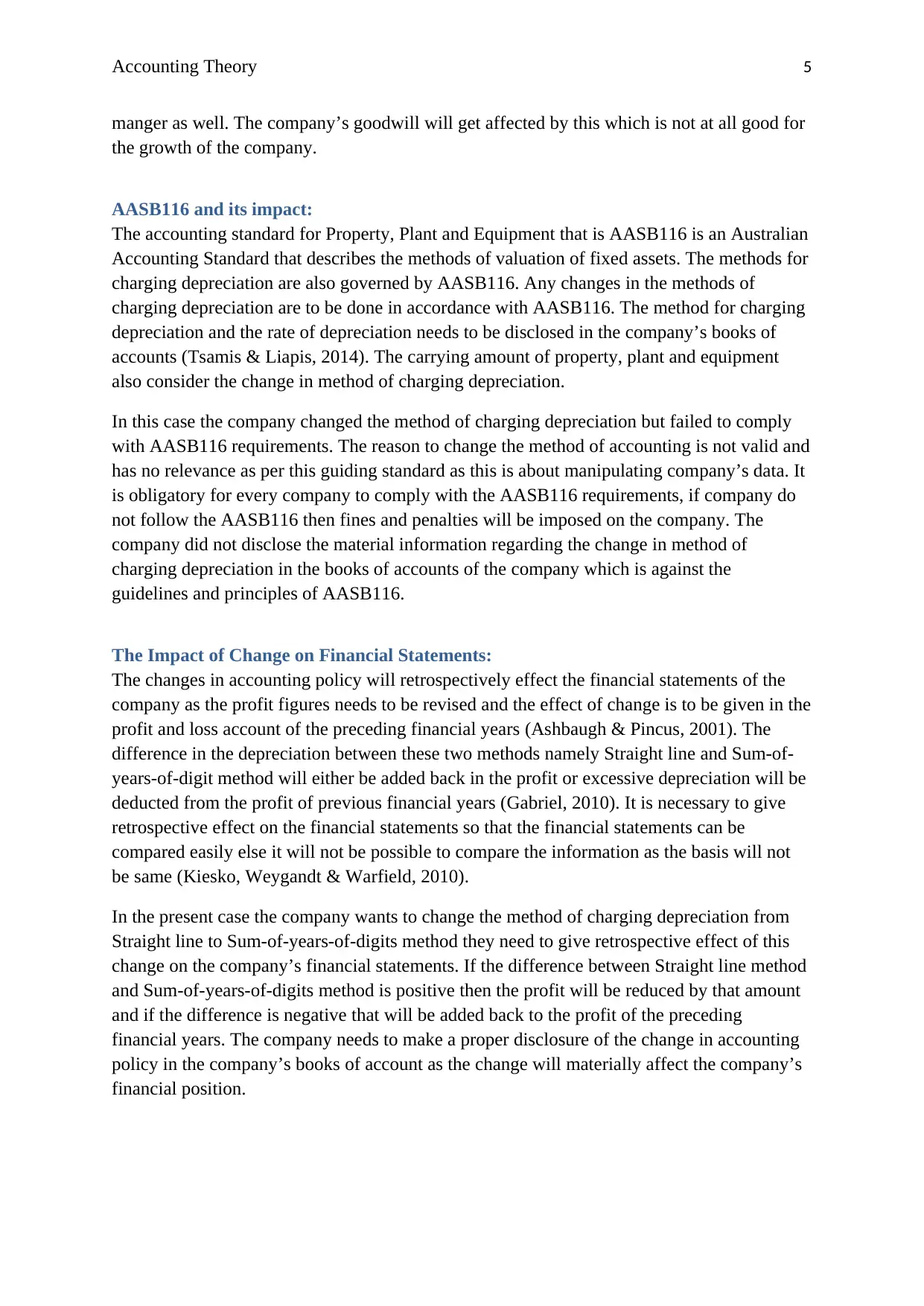
Accounting Theory 5
manger as well. The company’s goodwill will get affected by this which is not at all good for
the growth of the company.
AASB116 and its impact:
The accounting standard for Property, Plant and Equipment that is AASB116 is an Australian
Accounting Standard that describes the methods of valuation of fixed assets. The methods for
charging depreciation are also governed by AASB116. Any changes in the methods of
charging depreciation are to be done in accordance with AASB116. The method for charging
depreciation and the rate of depreciation needs to be disclosed in the company’s books of
accounts (Tsamis & Liapis, 2014). The carrying amount of property, plant and equipment
also consider the change in method of charging depreciation.
In this case the company changed the method of charging depreciation but failed to comply
with AASB116 requirements. The reason to change the method of accounting is not valid and
has no relevance as per this guiding standard as this is about manipulating company’s data. It
is obligatory for every company to comply with the AASB116 requirements, if company do
not follow the AASB116 then fines and penalties will be imposed on the company. The
company did not disclose the material information regarding the change in method of
charging depreciation in the books of accounts of the company which is against the
guidelines and principles of AASB116.
The Impact of Change on Financial Statements:
The changes in accounting policy will retrospectively effect the financial statements of the
company as the profit figures needs to be revised and the effect of change is to be given in the
profit and loss account of the preceding financial years (Ashbaugh & Pincus, 2001). The
difference in the depreciation between these two methods namely Straight line and Sum-of-
years-of-digit method will either be added back in the profit or excessive depreciation will be
deducted from the profit of previous financial years (Gabriel, 2010). It is necessary to give
retrospective effect on the financial statements so that the financial statements can be
compared easily else it will not be possible to compare the information as the basis will not
be same (Kiesko, Weygandt & Warfield, 2010).
In the present case the company wants to change the method of charging depreciation from
Straight line to Sum-of-years-of-digits method they need to give retrospective effect of this
change on the company’s financial statements. If the difference between Straight line method
and Sum-of-years-of-digits method is positive then the profit will be reduced by that amount
and if the difference is negative that will be added back to the profit of the preceding
financial years. The company needs to make a proper disclosure of the change in accounting
policy in the company’s books of account as the change will materially affect the company’s
financial position.
manger as well. The company’s goodwill will get affected by this which is not at all good for
the growth of the company.
AASB116 and its impact:
The accounting standard for Property, Plant and Equipment that is AASB116 is an Australian
Accounting Standard that describes the methods of valuation of fixed assets. The methods for
charging depreciation are also governed by AASB116. Any changes in the methods of
charging depreciation are to be done in accordance with AASB116. The method for charging
depreciation and the rate of depreciation needs to be disclosed in the company’s books of
accounts (Tsamis & Liapis, 2014). The carrying amount of property, plant and equipment
also consider the change in method of charging depreciation.
In this case the company changed the method of charging depreciation but failed to comply
with AASB116 requirements. The reason to change the method of accounting is not valid and
has no relevance as per this guiding standard as this is about manipulating company’s data. It
is obligatory for every company to comply with the AASB116 requirements, if company do
not follow the AASB116 then fines and penalties will be imposed on the company. The
company did not disclose the material information regarding the change in method of
charging depreciation in the books of accounts of the company which is against the
guidelines and principles of AASB116.
The Impact of Change on Financial Statements:
The changes in accounting policy will retrospectively effect the financial statements of the
company as the profit figures needs to be revised and the effect of change is to be given in the
profit and loss account of the preceding financial years (Ashbaugh & Pincus, 2001). The
difference in the depreciation between these two methods namely Straight line and Sum-of-
years-of-digit method will either be added back in the profit or excessive depreciation will be
deducted from the profit of previous financial years (Gabriel, 2010). It is necessary to give
retrospective effect on the financial statements so that the financial statements can be
compared easily else it will not be possible to compare the information as the basis will not
be same (Kiesko, Weygandt & Warfield, 2010).
In the present case the company wants to change the method of charging depreciation from
Straight line to Sum-of-years-of-digits method they need to give retrospective effect of this
change on the company’s financial statements. If the difference between Straight line method
and Sum-of-years-of-digits method is positive then the profit will be reduced by that amount
and if the difference is negative that will be added back to the profit of the preceding
financial years. The company needs to make a proper disclosure of the change in accounting
policy in the company’s books of account as the change will materially affect the company’s
financial position.
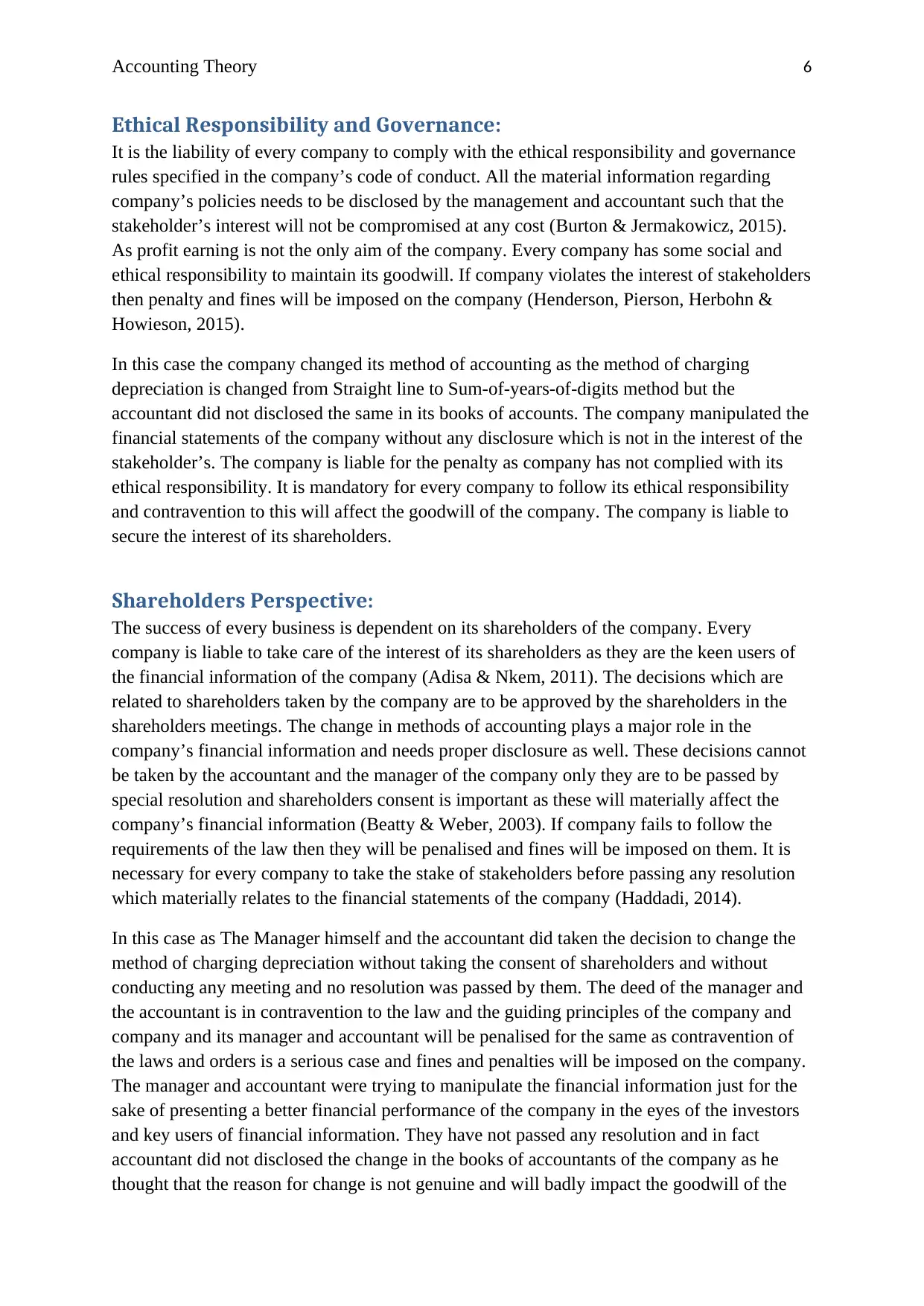
Accounting Theory 6
Ethical Responsibility and Governance:
It is the liability of every company to comply with the ethical responsibility and governance
rules specified in the company’s code of conduct. All the material information regarding
company’s policies needs to be disclosed by the management and accountant such that the
stakeholder’s interest will not be compromised at any cost (Burton & Jermakowicz, 2015).
As profit earning is not the only aim of the company. Every company has some social and
ethical responsibility to maintain its goodwill. If company violates the interest of stakeholders
then penalty and fines will be imposed on the company (Henderson, Pierson, Herbohn &
Howieson, 2015).
In this case the company changed its method of accounting as the method of charging
depreciation is changed from Straight line to Sum-of-years-of-digits method but the
accountant did not disclosed the same in its books of accounts. The company manipulated the
financial statements of the company without any disclosure which is not in the interest of the
stakeholder’s. The company is liable for the penalty as company has not complied with its
ethical responsibility. It is mandatory for every company to follow its ethical responsibility
and contravention to this will affect the goodwill of the company. The company is liable to
secure the interest of its shareholders.
Shareholders Perspective:
The success of every business is dependent on its shareholders of the company. Every
company is liable to take care of the interest of its shareholders as they are the keen users of
the financial information of the company (Adisa & Nkem, 2011). The decisions which are
related to shareholders taken by the company are to be approved by the shareholders in the
shareholders meetings. The change in methods of accounting plays a major role in the
company’s financial information and needs proper disclosure as well. These decisions cannot
be taken by the accountant and the manager of the company only they are to be passed by
special resolution and shareholders consent is important as these will materially affect the
company’s financial information (Beatty & Weber, 2003). If company fails to follow the
requirements of the law then they will be penalised and fines will be imposed on them. It is
necessary for every company to take the stake of stakeholders before passing any resolution
which materially relates to the financial statements of the company (Haddadi, 2014).
In this case as The Manager himself and the accountant did taken the decision to change the
method of charging depreciation without taking the consent of shareholders and without
conducting any meeting and no resolution was passed by them. The deed of the manager and
the accountant is in contravention to the law and the guiding principles of the company and
company and its manager and accountant will be penalised for the same as contravention of
the laws and orders is a serious case and fines and penalties will be imposed on the company.
The manager and accountant were trying to manipulate the financial information just for the
sake of presenting a better financial performance of the company in the eyes of the investors
and key users of financial information. They have not passed any resolution and in fact
accountant did not disclosed the change in the books of accountants of the company as he
thought that the reason for change is not genuine and will badly impact the goodwill of the
Ethical Responsibility and Governance:
It is the liability of every company to comply with the ethical responsibility and governance
rules specified in the company’s code of conduct. All the material information regarding
company’s policies needs to be disclosed by the management and accountant such that the
stakeholder’s interest will not be compromised at any cost (Burton & Jermakowicz, 2015).
As profit earning is not the only aim of the company. Every company has some social and
ethical responsibility to maintain its goodwill. If company violates the interest of stakeholders
then penalty and fines will be imposed on the company (Henderson, Pierson, Herbohn &
Howieson, 2015).
In this case the company changed its method of accounting as the method of charging
depreciation is changed from Straight line to Sum-of-years-of-digits method but the
accountant did not disclosed the same in its books of accounts. The company manipulated the
financial statements of the company without any disclosure which is not in the interest of the
stakeholder’s. The company is liable for the penalty as company has not complied with its
ethical responsibility. It is mandatory for every company to follow its ethical responsibility
and contravention to this will affect the goodwill of the company. The company is liable to
secure the interest of its shareholders.
Shareholders Perspective:
The success of every business is dependent on its shareholders of the company. Every
company is liable to take care of the interest of its shareholders as they are the keen users of
the financial information of the company (Adisa & Nkem, 2011). The decisions which are
related to shareholders taken by the company are to be approved by the shareholders in the
shareholders meetings. The change in methods of accounting plays a major role in the
company’s financial information and needs proper disclosure as well. These decisions cannot
be taken by the accountant and the manager of the company only they are to be passed by
special resolution and shareholders consent is important as these will materially affect the
company’s financial information (Beatty & Weber, 2003). If company fails to follow the
requirements of the law then they will be penalised and fines will be imposed on them. It is
necessary for every company to take the stake of stakeholders before passing any resolution
which materially relates to the financial statements of the company (Haddadi, 2014).
In this case as The Manager himself and the accountant did taken the decision to change the
method of charging depreciation without taking the consent of shareholders and without
conducting any meeting and no resolution was passed by them. The deed of the manager and
the accountant is in contravention to the law and the guiding principles of the company and
company and its manager and accountant will be penalised for the same as contravention of
the laws and orders is a serious case and fines and penalties will be imposed on the company.
The manager and accountant were trying to manipulate the financial information just for the
sake of presenting a better financial performance of the company in the eyes of the investors
and key users of financial information. They have not passed any resolution and in fact
accountant did not disclosed the change in the books of accountants of the company as he
thought that the reason for change is not genuine and will badly impact the goodwill of the
⊘ This is a preview!⊘
Do you want full access?
Subscribe today to unlock all pages.

Trusted by 1+ million students worldwide
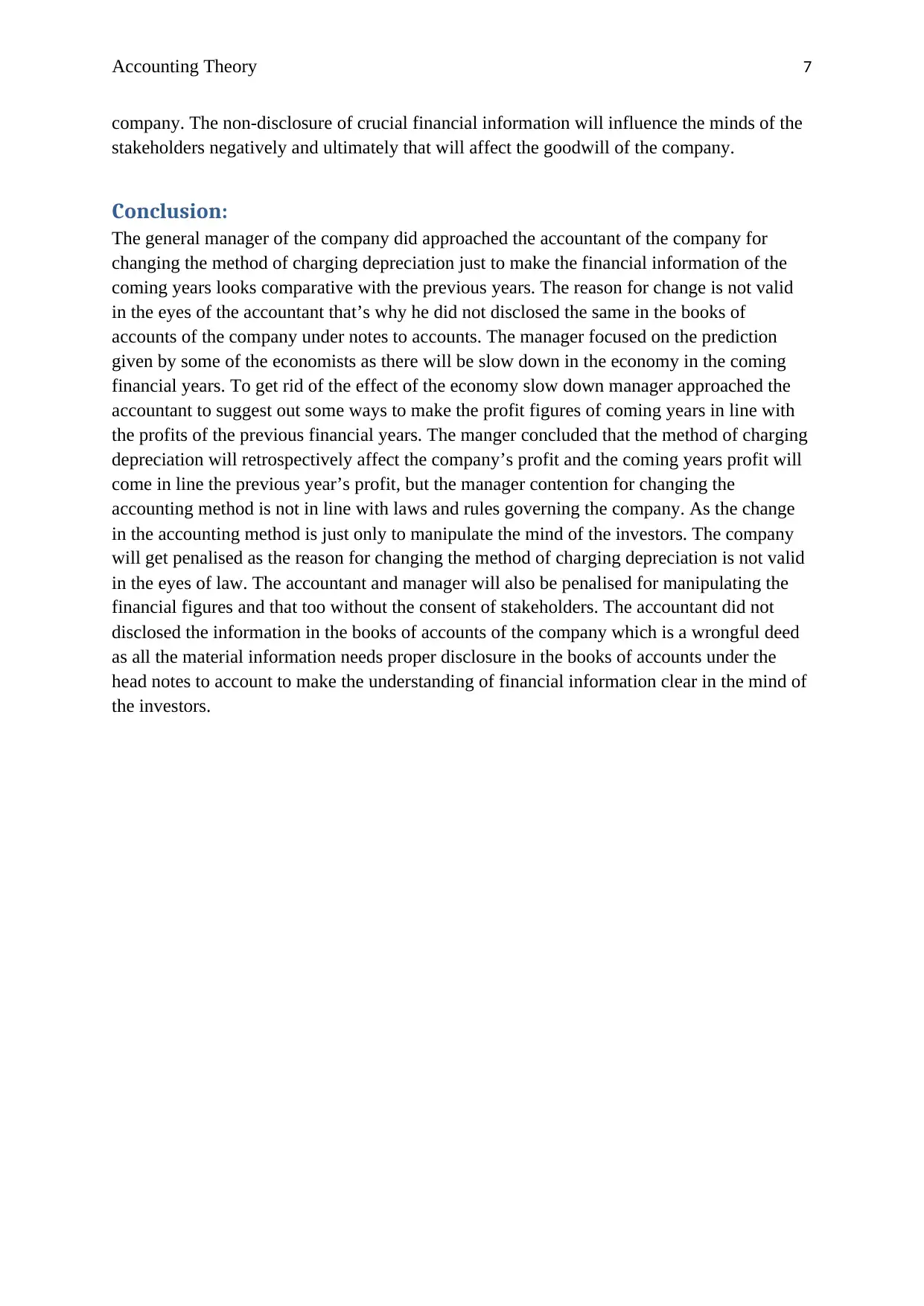
Accounting Theory 7
company. The non-disclosure of crucial financial information will influence the minds of the
stakeholders negatively and ultimately that will affect the goodwill of the company.
Conclusion:
The general manager of the company did approached the accountant of the company for
changing the method of charging depreciation just to make the financial information of the
coming years looks comparative with the previous years. The reason for change is not valid
in the eyes of the accountant that’s why he did not disclosed the same in the books of
accounts of the company under notes to accounts. The manager focused on the prediction
given by some of the economists as there will be slow down in the economy in the coming
financial years. To get rid of the effect of the economy slow down manager approached the
accountant to suggest out some ways to make the profit figures of coming years in line with
the profits of the previous financial years. The manger concluded that the method of charging
depreciation will retrospectively affect the company’s profit and the coming years profit will
come in line the previous year’s profit, but the manager contention for changing the
accounting method is not in line with laws and rules governing the company. As the change
in the accounting method is just only to manipulate the mind of the investors. The company
will get penalised as the reason for changing the method of charging depreciation is not valid
in the eyes of law. The accountant and manager will also be penalised for manipulating the
financial figures and that too without the consent of stakeholders. The accountant did not
disclosed the information in the books of accounts of the company which is a wrongful deed
as all the material information needs proper disclosure in the books of accounts under the
head notes to account to make the understanding of financial information clear in the mind of
the investors.
company. The non-disclosure of crucial financial information will influence the minds of the
stakeholders negatively and ultimately that will affect the goodwill of the company.
Conclusion:
The general manager of the company did approached the accountant of the company for
changing the method of charging depreciation just to make the financial information of the
coming years looks comparative with the previous years. The reason for change is not valid
in the eyes of the accountant that’s why he did not disclosed the same in the books of
accounts of the company under notes to accounts. The manager focused on the prediction
given by some of the economists as there will be slow down in the economy in the coming
financial years. To get rid of the effect of the economy slow down manager approached the
accountant to suggest out some ways to make the profit figures of coming years in line with
the profits of the previous financial years. The manger concluded that the method of charging
depreciation will retrospectively affect the company’s profit and the coming years profit will
come in line the previous year’s profit, but the manager contention for changing the
accounting method is not in line with laws and rules governing the company. As the change
in the accounting method is just only to manipulate the mind of the investors. The company
will get penalised as the reason for changing the method of charging depreciation is not valid
in the eyes of law. The accountant and manager will also be penalised for manipulating the
financial figures and that too without the consent of stakeholders. The accountant did not
disclosed the information in the books of accounts of the company which is a wrongful deed
as all the material information needs proper disclosure in the books of accounts under the
head notes to account to make the understanding of financial information clear in the mind of
the investors.
Paraphrase This Document
Need a fresh take? Get an instant paraphrase of this document with our AI Paraphraser
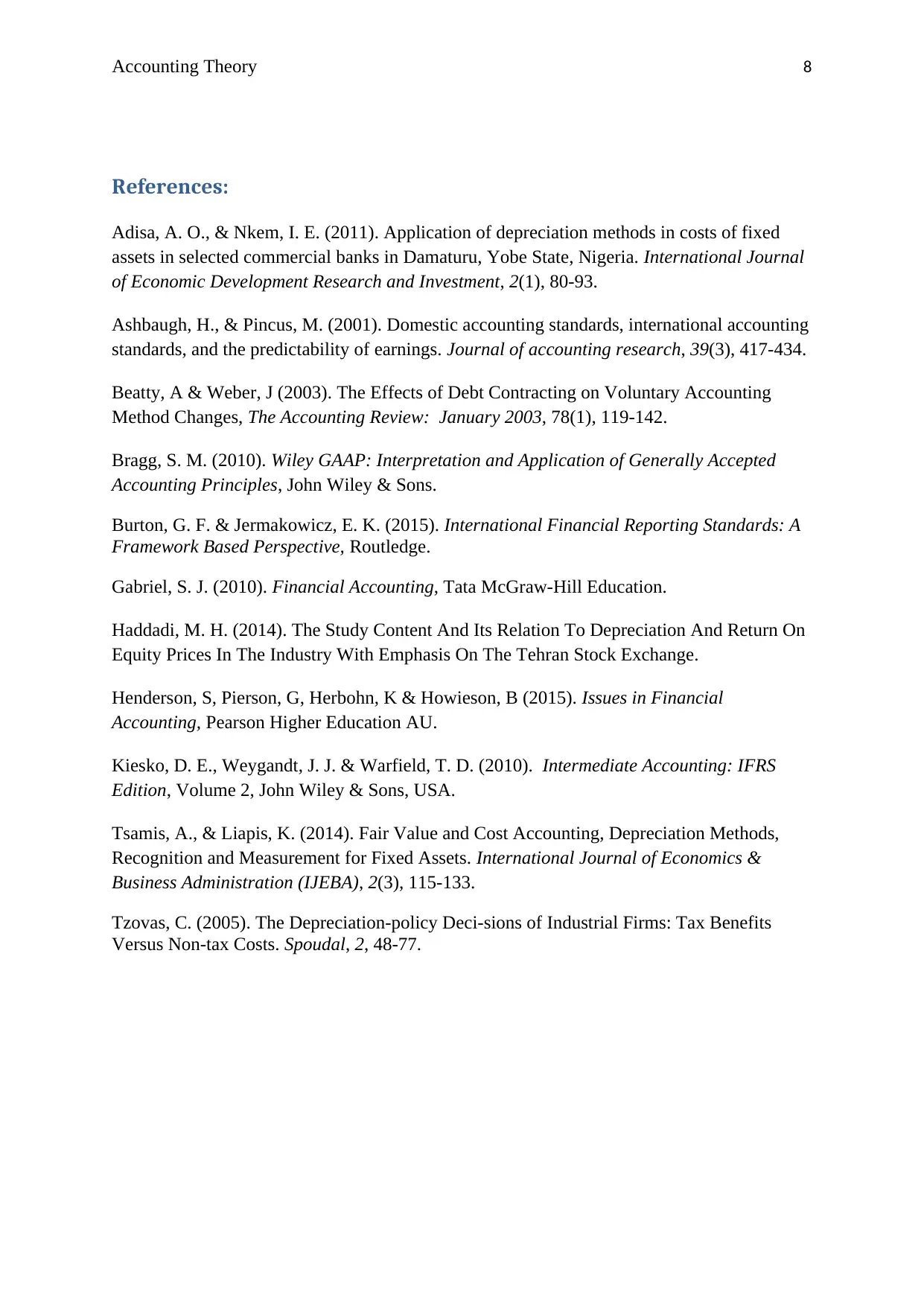
Accounting Theory 8
References:
Adisa, A. O., & Nkem, I. E. (2011). Application of depreciation methods in costs of fixed
assets in selected commercial banks in Damaturu, Yobe State, Nigeria. International Journal
of Economic Development Research and Investment, 2(1), 80-93.
Ashbaugh, H., & Pincus, M. (2001). Domestic accounting standards, international accounting
standards, and the predictability of earnings. Journal of accounting research, 39(3), 417-434.
Beatty, A & Weber, J (2003). The Effects of Debt Contracting on Voluntary Accounting
Method Changes, The Accounting Review: January 2003, 78(1), 119-142.
Bragg, S. M. (2010). Wiley GAAP: Interpretation and Application of Generally Accepted
Accounting Principles, John Wiley & Sons.
Burton, G. F. & Jermakowicz, E. K. (2015). International Financial Reporting Standards: A
Framework Based Perspective, Routledge.
Gabriel, S. J. (2010). Financial Accounting, Tata McGraw-Hill Education.
Haddadi, M. H. (2014). The Study Content And Its Relation To Depreciation And Return On
Equity Prices In The Industry With Emphasis On The Tehran Stock Exchange.
Henderson, S, Pierson, G, Herbohn, K & Howieson, B (2015). Issues in Financial
Accounting, Pearson Higher Education AU.
Kiesko, D. E., Weygandt, J. J. & Warfield, T. D. (2010). Intermediate Accounting: IFRS
Edition, Volume 2, John Wiley & Sons, USA.
Tsamis, A., & Liapis, K. (2014). Fair Value and Cost Accounting, Depreciation Methods,
Recognition and Measurement for Fixed Assets. International Journal of Economics &
Business Administration (IJEBA), 2(3), 115-133.
Tzovas, C. (2005). The Depreciation-policy Deci-sions of Industrial Firms: Tax Benefits
Versus Non-tax Costs. Spoudal, 2, 48-77.
References:
Adisa, A. O., & Nkem, I. E. (2011). Application of depreciation methods in costs of fixed
assets in selected commercial banks in Damaturu, Yobe State, Nigeria. International Journal
of Economic Development Research and Investment, 2(1), 80-93.
Ashbaugh, H., & Pincus, M. (2001). Domestic accounting standards, international accounting
standards, and the predictability of earnings. Journal of accounting research, 39(3), 417-434.
Beatty, A & Weber, J (2003). The Effects of Debt Contracting on Voluntary Accounting
Method Changes, The Accounting Review: January 2003, 78(1), 119-142.
Bragg, S. M. (2010). Wiley GAAP: Interpretation and Application of Generally Accepted
Accounting Principles, John Wiley & Sons.
Burton, G. F. & Jermakowicz, E. K. (2015). International Financial Reporting Standards: A
Framework Based Perspective, Routledge.
Gabriel, S. J. (2010). Financial Accounting, Tata McGraw-Hill Education.
Haddadi, M. H. (2014). The Study Content And Its Relation To Depreciation And Return On
Equity Prices In The Industry With Emphasis On The Tehran Stock Exchange.
Henderson, S, Pierson, G, Herbohn, K & Howieson, B (2015). Issues in Financial
Accounting, Pearson Higher Education AU.
Kiesko, D. E., Weygandt, J. J. & Warfield, T. D. (2010). Intermediate Accounting: IFRS
Edition, Volume 2, John Wiley & Sons, USA.
Tsamis, A., & Liapis, K. (2014). Fair Value and Cost Accounting, Depreciation Methods,
Recognition and Measurement for Fixed Assets. International Journal of Economics &
Business Administration (IJEBA), 2(3), 115-133.
Tzovas, C. (2005). The Depreciation-policy Deci-sions of Industrial Firms: Tax Benefits
Versus Non-tax Costs. Spoudal, 2, 48-77.
1 out of 8
Related Documents
Your All-in-One AI-Powered Toolkit for Academic Success.
+13062052269
info@desklib.com
Available 24*7 on WhatsApp / Email
![[object Object]](/_next/static/media/star-bottom.7253800d.svg)
Unlock your academic potential
Copyright © 2020–2025 A2Z Services. All Rights Reserved. Developed and managed by ZUCOL.





